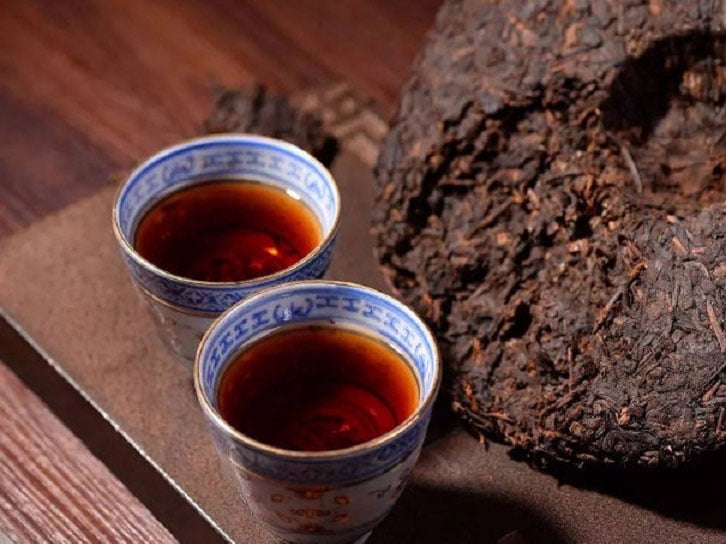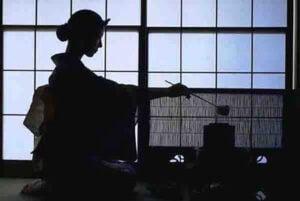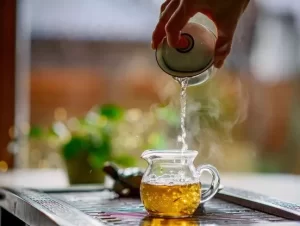清香Qingxiang is the flavor of freshness.
Pure (fresh) fragrance is often referred to as shen pueru fragrance or shai qing mao cha fragrance. Such a fragrance dokorinno differentiates itself from the strong, violent odors by its freshness, lightness and non-intrusiveness. It carries in itself simplicity and vishukanichnosti, characteristic of the smell of old mountain forest or neozorihhye onions and steppes. It is a very pleasant, natural and harmonious fragrance, which is different from the pungent, dry odors.
花香Huaxiang is a quotidian flavor.
The quintuple flavor is often found in shen puerhs and more rarely in shu puerhs. It is capable of sounding with different flavors:
a) 爽型花香 Xiangshuangxing Huaxiang is a refreshing, sour flavor. The most often bright and unforgettable impression on people are teas that have a bright, refreshing aroma of such colors as convallions or lilies. Such a fragrance sounds very pungent and pungent, but it is characterized by purity and naturalness. This fragrance brings aromatic pleasure without increasing plumming.
b) 甜醇型花香 Tianchunxin huaxiang is a malty, sour, sour spice flavor. It is often found in shen pueriwas, it reminds the flavor of jasmine. A cup of such fragrant tea clears your mind and banishes drowsiness, so tea with a bright sour sesame flavor is suitable for drinking in the late afternoon, when the body is in a state of fatigue, and thoughts lose their power.
(c) 柔和型花香:Low quidotic flavor. A clear application is the fragrance of trojande. It may appear in some shen pueris after a few years of storage. This flavor is different from the two described above delicate, pomirnoe sound and is very rarely found among puerhs. It can be the fragrance of orchids in tea, it is distinguished from the Trojandes fragrance by a lighter and more delicate, light and lightly flavorful sound.
糖香:Tangxiang is a tsukrowy flavor.
This flavor is found in puerhas quite often. Among the various flavors of zucrose aromas, the flavor of icepickle zucr is the most pronounced. As a rule, it is it that accompanies the sensation of freshness in the throat after drinking tea and bright malty aftersmack, which comes to change the tea girkota and tartness. That is why the presence of cucumber flavor is considered to be a sign of quality tea products.
水果香 Shuigoxiang is a fruity flavor.
This flavor is often found among puerhas. The reasons for the formation of these aromas in tea are ambiguous: some teas initially contain aromatic substances with a fruity odor, in some teas fruit aroma is the result of mixing of several different odors. The presence of fruit flavor is a widespread phenomenon. The smell of apple is most often impregnated in young loose teas, while the smell of kavun can sometimes be found in shen puerhs that have been in storage for a long time.
梅子香 Meijixiang is a plum flavor.
After a few hours of preservation, the aroma of shen puerh has plum notes. This is considered to be a good, classic shen puerh flavor. As a result of improper fermentation or improper storage, some teas can also acquire a sour odor, which many people mistake for plum flavor, while there is a significant difference between these two odors. Plum aroma sounds very soft and natural, while the “wrong” sour smell is very harsh and intrusive. Plum flavored tea gives a very pure tea with a natural, natural flavor. Tea with the wrong sour flavor gives a tea with sour notes in its flavor. Both in the process of natural and in the process of unit fermentation in tea are formed such fatty acids as pentanoic (valer’yanovoy) acid, capric acid and others. Improper fermentation leads to the accumulation of a large amount of these acids and, as a result, to the formation of extremely sour taste and odor, which in turn has a direct impact on the taste and aromatic characteristics of tea.
蜜香Misian is a honey flavor.
During storage, different teas from different tea regions can develop a honey aroma over a long period of time. This flavor is very persistent, easy to understand, easy to describe, and therefore easy to smell. Pueri, which have a honey flavor, are characterized by a very high quality. Sometimes a single brew of pure, unadulterated honey-scented puerh is enough to make you feel the after-smack in your mouth all day long.
坚果香Jianguoxiang is a mountain flavor.
This fragrance sounds with notes of migdalu or cedar mountains. It is very rare, mainly characteristic of some shu puerhs or very popular shen puerhs.
陈香Chenxiang is vitrimanium aroma (the aroma of vitrimanium tea).
It is characteristic of shu puerh and also for shen puerh, the fermentation level of which during the period of long-term storage has approached the fermentation level of the vitrified finished puerh. The pure odor of vitrimanosti (vitality) is the dominant aroma of shu puerh and is considered to be its distinctiveness and visa card. This fragrance is reminiscent of the deep odor that resembles old wooden furniture. It must be vitriolic (“old”), but at the same time it must have vitality, energy, without arousing associations with something musty and stifling. Vitrimanium aroma is a complex, combinovanii aroma of wood and the smell of medicinal herbs.
枣香Zaoxiang is the flavor of Chinese fi niques.
This fragrance is the classic scent of puerhas. It resembles the odor of dry finiqi and is often a prominent odor of shu pueri.
木香: Musian is a village’yanyi flavor.
The flavor of puerhas is extremely widespread, especially pronounced in shu puerhas. It is distinguished from the bright kvitkovyh and honey flavors by its quality and pomirnosti. It’s a flavor that speaks to the quality of the puerre.
樟香 Zhangxiang is a camphor flavor.
This flavor is mostly found in shen puerhas during long-term storage. It is reminiscent of camphor wood aroma, sounds very harmonious, smooth and natural.
烟熏味 Yanxunwei is a dim sum flavor.
This aroma is not the natural smell of tea, it is leaked from the tea leaves during processing or storage. The presence of a dim aroma in tea is a widespread phenomenon, but this aroma is a third-party odor and does not have any positive effect on the quality of tea. During the wet season in the production of shai ching mao tea, the tea often needs to be brought into the room for drying to prevent it from getting wet. The houses of villagers who live in mountainous areas are permeated with the odor of dim sum, which is easily transmitted to the tea leaves. This way the tea gets a dim flavor.
烟焦味Yanjiaowei is the smell of dimno obvuglenosti.
This odor is also found in puerhas quite often and is a negative example of the aromatic properties of tea. It is formed in the process of “green fixation”, if the temperature during fixation was too high and part of the leaf was burned. The odor of diminutive obvuglenosti is only found in those puerhs that have been coarsely processed.
药香 Yaoxiang is an herbal’yano-l medicinal flavor.
This is the aroma of medicinal herbs used in Chinese medicine. It is similar to the smells that can be caught in pharmacies that specialize in the sale of local medicines. This fragrance also reminds of the smell of herbs and plants, which have been sphilni to a long preservation. Being a plant, tea naturally acquires similar notes in the process of long-term preservation. In the eastern regions, which are characterized by hot and humid climate, the savoring and aromatic qualities of tea during its preservation change much faster than in the eastern regions with dry climate. That is why the flavor of tea, which is preserved for a number of years in the east, can later acquire notes of medicinal herbs. Storage of tea in the eastern latitudes makes it difficult for a similar flavor to appear even after a long period of time.
酸菜气Suanqaiqi is the smell of sour vegetables.
Young, freshly made shen puerh may have an odor reminiscent of the smell of sour vegetables. It is not an external odor that is removed from the bottom, such an odor is produced during the processing of tea leaves at the stage of 晒青 “Shaqin” (sun-drying). In many tea factories during tea production, after the 杀青 “shaqing” (killing of the greens) stage, the tea is sometimes put into large bundles and left in this state for some time. Thanks to this procedure, after further drying, the tea yields an infusion, the color of which looks glossy, the flavor – strong, and the aroma gains original notes. However, if the tea is retreated in this condition, it gives a flavor similar to that of sour vegetables.
日晒味:Zhishaiweiis the smell of “sunshine”. Often present in laundry that has been dried on the sun. This fragrance is reminiscent of the smell that resembles the smell of a cowdung dried on the sun in clear weather.
Our most popular Puers
-
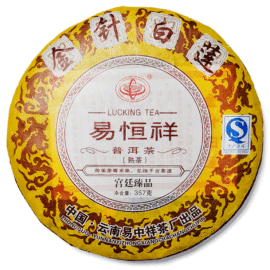 Golden Needle White Lotus 2013, Shu Puer tea (No360)972₴ /100g
Golden Needle White Lotus 2013, Shu Puer tea (No360)972₴ /100g -
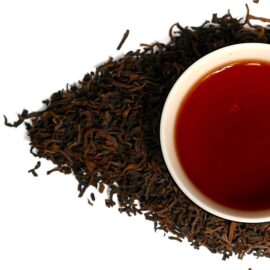 Menghai tea Shu Puer (No. 120)234₴ /50g
Menghai tea Shu Puer (No. 120)234₴ /50g -
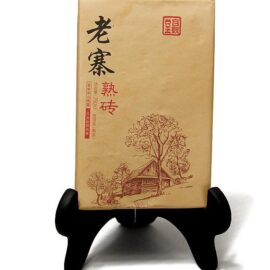 Shu Puer Cha Chuan Pressed Tea 2013 (No. 280)392₴ /50g
Shu Puer Cha Chuan Pressed Tea 2013 (No. 280)392₴ /50g
